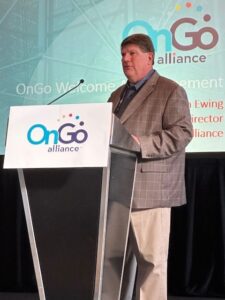
The OnGo Alliance wrapped up its fall members meeting in Dallas recently, and the message was clear: CBRS technology is essential. Over two days at the Hyatt Regency Dallas, industry leaders, innovators, and member companies gathered to showcase how CBRS is enabling connectivity transformation in industries from aviation to agriculture to broadband services.
From Innovation to Infrastructure
The numbers tell a compelling story. The CBRS ecosystem has deployed more than 420,000 radios across airports, factories, schools, hospitals, and rural communities. Investment has been substantial, with rural WISPs alone contributing over $7 billion and total ecosystem investment exceeding $14 billion. This isn’t speculative spending – it’s a clear market signal that CBRS has arrived as business-critical infrastructure.
“The presentations and discussions at our Dallas meeting clearly demonstrate that CBRS has evolved into an essential asset,” noted Alan Ewing, Executive Director from the OnGo Alliance. “From regional airports to enterprise networks and rural broadband initiatives, we’re seeing CBRS enable innovative communication solutions that were simply not possible with traditional wireless approaches.”
Real-World Applications Making Real Impact
Tuesday’s sessions brought particularly impressive case studies from the field. Michael Youngs, CIO at DFW International Airport, demonstrated how the world’s third-busiest airport is using CBRS to power Airport 4.0 initiatives. Their IoT-driven approach includes sensors that are projected to reduce maintenance costs by 20% and advanced surveillance systems that enhance security operations. Norman Fekrat from Imagine Wireless emphasized how access to shared spectrum, such as CBRS, empowers the aviation industry to add multi-billion-dollar value to the U.S. economy.
Regional airports are also seeing transformative results. Rob Cerbone, Vice President of Marketing at Communication Technology Services, presented on Tulsa International Airport’s private cellular implementation, which is setting new benchmarks for regional aviation connectivity. These aren’t futuristic concepts – they’re operational networks delivering measurable value today.
Connecting Rural America
David Zumwalt, President and CEO of WISPA, provided insights into how wireless internet service providers are leveraging CBRS technology to bridge the digital divide. For rural communities that traditional infrastructure often overlooks, CBRS offers a viable path to high-quality broadband access.
Chris Crowe, owner of t3 Broadband, took this concept into the fields – literally. His presentation on “The Digital Revolution of American Farms” explored how CBRS enables precision agriculture, allowing farmers to leverage modern technology for improved operations. From soil sensors to autonomous equipment, the connectivity backbone that enables smart farming increasingly relies on CBRS networks.
Charting the Path: Market Momentum and Policy Progress
Kyung Mun, Principal Analyst at Mobile Experts, offered a comprehensive market analysis on the role of private LTE and 5G in enterprise networking. The projections for private cellular deployment across industrial environments continue to trend upward, driven by tangible benefits in operational efficiency, security, and customization.
The regulatory landscape also received significant attention. A panel featuring experts from JMA, Federated Wireless, CableLabs, and WISPA discussed the latest policy developments affecting CBRS deployment and adoption. As the technology matures, thoughtful regulation continues to play a crucial role in enabling innovation while managing spectrum efficiently.
Building the Ecosystem Together
Beyond the presentations, the meeting served as a vital touchpoint for the CBRS community. A networking reception provided attendees with the opportunity to explore potential partnership opportunities and discuss collaborative initiatives. Wednesday’s sessions dove into OnGo Alliance working groups, covering Neutral Host Networks, regulatory initiatives, and business deployment enablement efforts.
The new board members for the OnGo Alliance shared their views and provided updates on certification and testing programs – the behind-the-scenes work that ensures multi-vendor interoperability and maintains the ecosystem’s reliability.
Resources for Implementation
For organizations considering CBRS deployment across any use case – whether private networks, fixed wireless access, or neutral host solutions – the OnGo Alliance has released an updated edition of its OnGo Deployments eBook, featuring successful implementations across various industries. This practical resource is available for download at the Alliance’s website.
The new board members for the OnGo Alliance shared their views and provided updates on certification and testing programs – the behind-the-scenes work that ensures multi-vendor interoperability and maintains the ecosystem’s reliability. They also highlighted new resources to support deployment decisions, including the Alliance’s TCO calculator, which helps organizations evaluate the economic benefits of CBRS solutions across different deployment situations.
Looking Ahead
The Dallas meeting confirmed what industry watchers have been observing: CBRS has reached an inflection point. What began as a novel approach to spectrum sharing has matured into proven infrastructure supporting mission-critical operations across diverse sectors. With dozens of member organizations and a growing ecosystem of deployments, the OnGo Alliance continues to drive standardization and adoption while supporting innovative applications of the technology.
As enterprises increasingly recognize the limitations of one-size-fits-all wireless solutions, CBRS offers the control, security, and customization that modern operations demand. Based on what we saw in Dallas, 2025 is a landmark year for CBRS.
